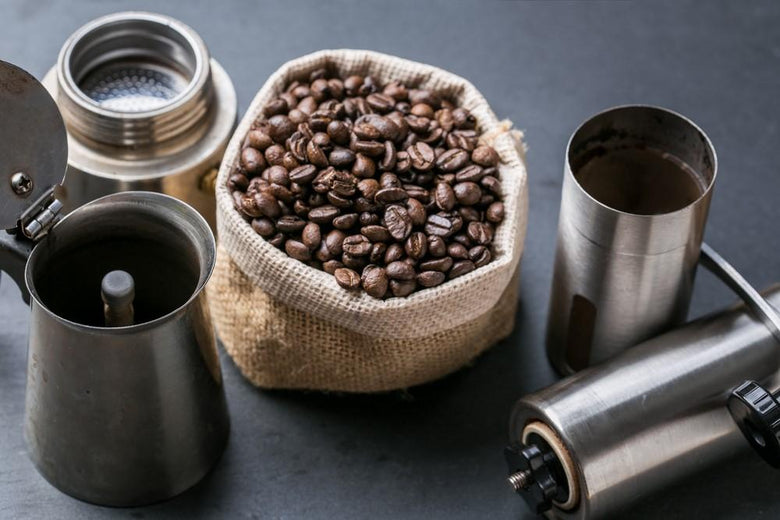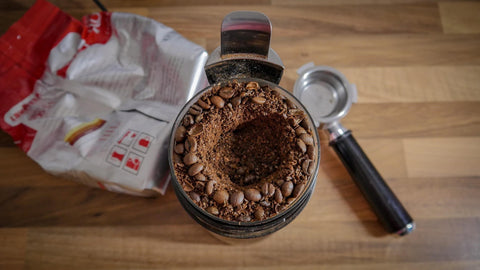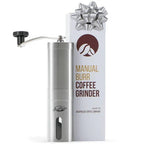Your coffee grinder is your most important piece of coffee gear. No, really. It’s what turns your whole beans into brewable grounds and unlocks the flavor treasures within.
Uniform coffee grounds are the key to a balanced extraction. A capable brewer, good technique are too - but it all starts with the grinder.
You can get tasty coffee with a good grinder and bad brewer - but you’ll never get tasty coffee with a bad grinder and a stellar brewer. Once the beans are in your hand, quality starts with the grinder!
However, sometimes our grinders don’t perform as well as we’d like. They either lose effectiveness over time or they have random off-days.
Believe it or not, there’s actually some technique involved with manually grinding coffee. There are also some best-practices you should be following - and they’re all very easy to stick to.
Read: Why Your Grinder Is The Most Important Piece of Coffee Gear
If you follow these tips and insert these practices into your regular coffee routine, you’ll find that your coffee will taste more balanced and delicious. A little effort here goes a long way - so let’s jump in!
1. Hold The Grinder Completely Vertical
With most grinders, holding the device at an angle is the most comfortable grinding position. It’s what feels most natural with our wrists.
However, grinding at too great an angle can hurt your grind consistency.
Think of the burrs.
- The outer burr has sharp ridges facing in and downward
- The inner burr has sharp ridges facing sideways and up
- The beans are funneled straight down from the hopper into the burrs
If the beans aren’t funneled directly down, a few things happen.
- The burrs become unaligned. The lower end of the burrs has more beans fall into it, causing the gap between two burr pieces to widen slightly and reducing overall consistency.
- Some beans are forced through the burrs too quickly. Beans ground at the lower end are pushed down by the beans above them with more weight than normal, which causes them to be forced through the burrs a bit more quickly than the others going through the burrs on the upper end.
Read: What To Look For In A Travel Coffee Grinder
These two events can end up hurting your grind uniformity - and these small grind uniformity changes can lead to big flavor changes.
If you're not getting a grind uniformity you're happy with, try holding the grinder straight up.
2. Anchor The Grinder To The Counter
We tend to seek the quickest way to grind coffee. One way we do this is by turning the handle with one hand while spinning the body of the grinder in the opposite direction.
I totally get it - it’s faster.
However, this can also introduce some inconsistency.
Those beans in the hopper and in the burrs are being flung around like crazy. Some of the grounds are being thrown upward out of the burrs to be ground again - and some are being ejected from the burrs before they’ve been ground down to the right size.
Like we just discussed, you want the beans to funnel straight down without being knocked around much at all.
Read: How To Brew Better Coffee By Adjusting Your Coffee Grind Size
The best way to keep yourself from flinging the grinder everywhere is to anchor the device against your kitchen counter or table. It’ll also help you keep the grinder vertical while you grind.
(Realistically, most people don't do this. But it is the best way to give your grounds the best chance of being uniformly-sized.)
Pro Tip: Set a towel between the grinder and the counter to absorb noise and vibrations.
3. Give The Burrs A Cleaning
Your grinder’s burrs, like everything else in the world, need a cleaning every now and then. Natural oils from previous coffee eventually build up on the burrs, as well as microscopic coffee particles.
These can be scraped off the burrs by fresh beans and brewed into your mug days or weeks later, but they typically don’t taste good at all - and the oils can even go rancid after months and months of hanging around.
This is why fancy specialty shops clean their espresso grinders every single day!
Read: How To Pair Your Coffee Brewer With Its Perfect Grind Size
Thankfully, it’s pretty easy to do, especially if you have a manual grinder. Here’s a quick breakdown of the burr cleaning steps:
- Disassemble the grinder. Do it over a white towel so that you can easily keep track of the smaller pieces. If you need to, make a quick note about the order of the pieces around the rod, like washers and springs.
- Wipe the burrs with soapy water. Just a drop or two of dish soap in a small cup of water will give the oil-fighting power a Q-tip needs to break down the most annoying oils and stuck grounds. Other small parts can also be cleaned this way.
- Wipe with a clean, dry towel. Thoroughly wipe down the burrs with a fresh towel to remove the soap, oils, and grounds. Leave the pieces out to dry for a couple hours.
- Reassemble the grinder. Put it all back together and grind some coffee!
The cleaning process takes only 5-10 minutes. I suggest doing it every 1-2 months to keep your coffee tasty.
Read: The Easy Guide to Cleaning Your Manual Coffee Grinder
4. Replace The Burrs Periodically
No burrs last forever. Even ceramic burrs like we use in our JavaPresse Grinder, which become dull far more slowly than steel burrs, can lose their razor sharpness or even break.
Most people never replace their burrs, unfortunately, which means their coffee grounds are suffering in uniformity - maybe dramatically.
Don’t be “most people”. Don’t use the same burrs for the next decade.
We suggest switching out your burrs every 1-2 years to maintain maximum effectiveness.
5. Blade Grinder? A Few Tips For You
Well, I’ve just got to be honest with you. If you use a blade grinder, you’re shooting yourself in the foot… big time.
Read: Blades VS Burrs: What Is the Best Type of Coffee Grinder?
Blade grinders are terribly inconsistent because they don’t have controlled burrs. They just chop up the beans with really ineffective and often dull blades.
However, if a blade grinder is all you have, I get it. I was in your spot once too.
So let me give you a few tips:
- Shake while you grind. No really. Blade grinders are terribly at chopping up all the beans evenly. Sometimes there are nearly whole beans left! One solution is to shake the grinder so that all the grounds are forced through the blades repeatedly, rather than just 60-80% of them.
- Pulse press the button. I know it seems counterintuitive to not just hold down the grind button, but it’s another way to encourage better mixing of the beans for a more uniform grind.
Do both of these at the same time and you’ll have a more consistent grind than ever.
However, sadly, it’ll never be as consistent as just using a burr grinder (and you can get a good one for less than $40).
---
I realize that these tips may seem too minor to really make any significant change, but this is your daily mug of happiness we’re talking about.
And we both know how disappointing it is when our mug of happiness tastes meh!
But these tips are so easy.
And, just like life, the little things do matter. Your coffee will thank you. Your taste buds will thank you. And your morning will be a little brighter.
Of course, the higher quality your beans, the more forgiving they are when you don’t grind with perfect technique.



